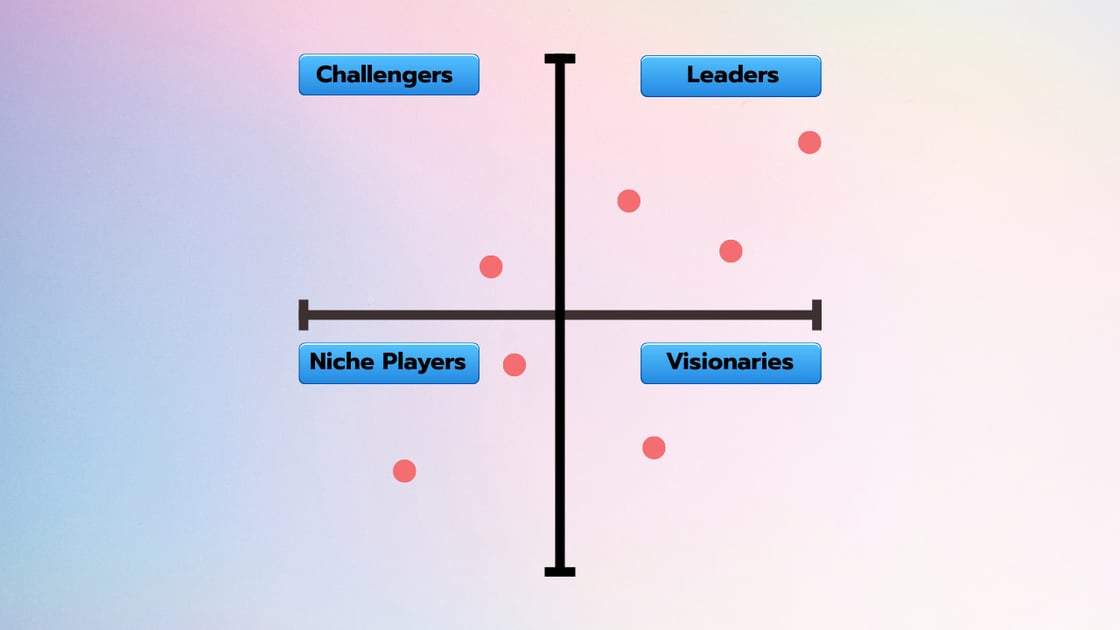If you’re a vendor for IT software or a C-level employee in an organization who needs to buy the best business apps, you must know what Gartner Magic Quadrant is.
There are primarily two dilemmas in the business-to-business (B2B) procuring, marketing, and sales sectors. One smartly manages your budget for business apps, services, and systems so that you can get the maximum return on investment (ROI).
The other one is, being a vendor of such products, how you position yourself so that you win more deals as compared to your competitors.
Whether you’re selling IT services and software or buying such stuff, you must follow a standard ranking system that is acclaimed by global IT leaders. One such standard is the Gartner Magic Quadrant (MQ).
In the IT sector, the Gartner MQ is the Holy Grail of the latest qualitative and quantitative reports on IT market trends, who’s winning in providing which IT service or software capabilities, which company is challenging the status quo, and so much more.
If you’re an IT consultant, business owner, startup founder, or aspiring professional to get a high-paying salary in this sector, you must know what Gartner MQ is and how it helps businesses globally.
What Is Gartner Magic Quadrant?
The Gartner Magic Quadrant (MQ) report provides a simple graphical representation that quickly conveys a company’s position in the market.
In the business sector, IT admins, managers, procurement decision-makers, startup founders, and C-level executives refer to the Gartner Magic Quadrant for complete research on various IT technology, software or services vendors, and more.
This qualitative and quantitative research uses an X-axis and Y-axis quadrant to represent four types of players in the IT market. These are the Niche Players, Challengers, Visionaries, and Leaders.
The graph creates a visual representation of the vendors or companies of various IT services and software providers. Suppose you’re looking for Account-Based Marketing Platforms to buy a cost-effective, affordable, and easy-to-use ABM software for your marketing agency.
To understand which vendor will be suitable for this deal, you can read the Gartner MQ for Account-Based Marketing Platforms report. To look at Gartner Magic Quadrant (MQ) from the vendor’s perspective, software, and IT services provider companies present their presence in the Gartner MQ as solid proof that they are worthy of your investments for services and apps.
Gartner publishes an updated MQ chart each year and updates it throughout the year. The IT consultancy giant covers almost all the B2B IT niches like Ad Tech, B2B Marketing Automation Platforms, Clinical Communication and Collaboration, and many more.
It organizes the research reports in digital (1 to 0) and alphabetical (A to Z) on the Gartner Magic Quadrant & Critical Capabilities portal. You can just visit the portal, choose the area of your interest in the IT niche, and download the research report against a fee or become a client of Gartner to access all the research reports.
Variants of Gartner Magic Quadrant
The Gartner MQ has different variants to provide data-driven insights to various sectors of the IT industry. Since the Gartner MQ is mostly related to B2B transaction decision-making, C-level professionals and business owners stick to the niche they know most or the niche in which they need a software or managed IT service provider.
Find below the notable variants of Gartner MQ:
- Gartner MQ for IT Services: This quadrant variant assesses companies offering IT services, including consulting, outsourcing, and managed services. So, if you need to find which company stands in which section of the quadrant, like Leaders or Challengers.
- Gartner Magic Quadrant for Cloud IaaS: This quadrant monitors, audits, and evaluates various cloud service providers and places them on the quadrant as Leaders, Visionaries, Challengers, and Niche Players.
- MQ for Business Intelligence and Analytics Platforms: Suppose you’re a BI and data analysis services provider. If you find your company’s name in the Gartner MQ for BI and Analytics, then you can position yourself as a high-quality vendor who can service small businesses to enterprises effectively.
- Gartner Magic Quadrant for Enterprise Network Firewalls: If you need physical and virtual network security solutions for your business, you can check out this Gartner MQ variant to select the best vendor.
- Gartner Magic Quadrant for CRM: Suppose you’re in the CRM development and selling business for customer service or marketing agencies. Now, you want to know how your competitors are performing in this niche. You can get this report to understand the competition in the market and how the competing vendors can deliver according to the end user’s requirements today and in the future.
Also read: Infrastructure as a Service (IaaS): Everything You Need To Know
Quadrants of Gartner MQ

The Magic Quadrant of Gartner segments companies of a select SaaS product in two different axes. These are according to the Ability to Execute on the X-axis and the Completeness of Vision on the Y-axis.
Also read: SaaS Marketing explained in less than 7 minutes
Find below the graphical competitive positioning type of a Gartner MQ report:
#1. Leaders
Companies deemed as a Leader in a niche IT service or technology show up on the top-left quadrant of the chart. These companies possess strong capabilities to deliver and execute their plans today and in the future.
They also possess a comprehensive view of the technology or product in the future. Leaders are the most stable and dependable choices for certain IT services or products in the market. However, prices of their services can be extremely costly.
Example: Microsoft is the leader in ECM (Enterprise Content Services Platform) according to September 2021 Gartner MQ
#2. Challengers
The Challengers of a select technology will show up on the top-right quadrant of Gartner MQ. IT vendors, service providers, agencies, etc., falling in this category can deliver their tasks well. However, they lack the quality of vision as compared to the Leaders of the Gartner MQ research report.
Companies in this section are also reliable and solid in terms of brand value. However, they may not be able to push the projects of research and development for the future.
Example: SAP is the Challenger for the CRM Customer Engagement Center as of the May 2021 Gartner MQ research report
#3. Visionaries
In the bottom-left section of the quadrant, you’ll find the Visionaries in the niche of the IT service that you’ve chosen from the Gartner repository for Magic Quadrants and Critical Capabilities. These are highly innovative vendors or companies in a select IT sector, Also, they’ve got a clear vision for the future to drive their growth.
However, Visionaries might not be able to execute their plans as effectively as the Leaders and Challengers on the Magic Quadrant.
The Visionary companies of the Gartner MQ are known for out-of-the-box thinking and introducing new ideas, hypotheses, and technologies for the IT industry.
Example: Newgen falls in the Visionaries section in ECM according to the September 2021 Gartner MQ
#4. Niche Players
You’ll find the Niche Players in the bottom-right quadrant. These companies mainly focus on a narrow market segment or niche. However, the Niche Players excel in the IT technology or service they focus on. Their services may not be well suited for all businesses.
If you’re looking for specialists in niche IT services like Ad Tech, Ed Tech, etc., go for Niche Players rather than Leaders because Niche Players should be able to offer a mix of value and affordability.
Example: NetDocuments is a Niche Player in the ECM sector according to September 2021 Gartner MQ
Working Process of the Gartner MQ

The Gartner MQ operates within two axes, the X-axis and the Y-axis, to assess and categorize technology companies.
The X-axis, called “Ability to Execute,” measures a company’s capability to deliver its products and services effectively. It considers factors like financial stability, market presence, product reliability, and customer service.
It places the companies with strong execution abilities on the right side of the quadrant, while those with less execution ability are present on the left.
The Y-axis, known as “Completeness of Vision,” evaluates a company’s forward-thinking approach. It also considers the company’s ability to anticipate and meet future market needs.
Completeness of Vision evaluates factors like innovation, strategy, product roadmap, and responsiveness to market changes. Companies with a comprehensive vision find themselves in the upper part of the quadrant, while those with a narrower vision are in the lower part.
The combination of these two axes results in the following four quadrants:
- Leaders (Top-Right): These companies excel in execution and have a broad vision for the future
- Challengers (Top-Left): They execute well but may have a more limited vision
- Visionaries (Bottom-Right): These companies have a strong vision but may not execute as effectively as Leaders
- Niche Players (Bottom-Left): They focus on specific areas and may have limited execution ability
This quadrant system simplifies complex evaluations, helping businesses quickly understand where technology companies stand in terms of both current performance and future outlook. Thereby aiding in the decision-making processes like buying business software, investing in software development companies, etc.
Business Use Cases of Gartner MQ
Scenario 1

Your organization needs a human capital management (HCM) suit on the cloud. Depending on your needs and budget, first access the specific Gartner MQ report on HCM in the current year.
Focus on the vendors placed in the Leaders and Challengers quadrants. These vendors are often more established and have a track record of delivering effective HCM solutions. However, their product pricing may be a bit higher than the Niche Players.
After selecting a few vendors in the different quadrants, thoroughly read their profiles on the report as well as on their official websites. Narrow down to a specific vendor, further analyzing the cost of the software ownership.
Also read: Best HR Chatbots for improved employee engagement
Scenario 2

Suppose you’re the HCM solution developer and seller. To reach out to more customers and close deals, first find out your position on the Gartner MQ. This will give you insight into how the Gartner analysts perceive your software’s performance.
Also, pay attention to any areas where your software may have been rated lower. Use this data to discover opportunities for improvement. If possible, engage with Gartner analysts to discuss your positioning and seek guidance on strategies for improving your quadrant placement.
Don’t forget to incorporate your placement in the Gartner Magic Quadrant into your marketing materials, website, and sales collateral to build trust with potential customers.
Moreover, you should train your sales team to understand the significance of the quadrant and how to use it during sales pitches to demonstrate your competitive advantage.
Advantages of Using Gartner MQ
- It also allows for easy side-by-side comparison of multiple companies, aiding decision-making.
- Gartner’s research and analysis provide an objective assessment of IT software and infrastructure companies.
- When Gartner includes your company in their Magic Quadrant, you can position your business as a reputed and credible vendor in that specific IT niche.
- You can choose a suitable IT vendor based on the reports of Gartner MQ.
- Gartner MQ also provides insights into potential risks and challenges associated with technology providers.
- Investors often use the Magic Quadrant to gauge the potential of technology companies.
- Niche Players, Challengers, and Visionaries work continuously to enhance their performance and vision to upgrade themselves to the Leaders quadrant.
Drawbacks of Gartner MQ
- The quadrant system oversimplifies complex evaluations.
- Also, the report could miss potentially nuanced information.
- Gartner’s criteria and scoring can be subjective, leading to disputes about a company’s placement.
- Not all technology providers are included, leaving out potentially valuable options.
- Some companies may tailor their strategies to improve their Magic Quadrant positioning rather than focusing on true innovation.
Conclusion
Many reputed businesses and most enterprise-level businesses consider Gartner as one of the most respected and trusted analyst firms when it comes to IT infrastructures, services, and software ratings.
So, where your IT company stands on the Gartner MQ for a specific technology or SaaS product matters a lot. Also, if you’re a business manager with buying roles in your organization, you must follow all the latest Gartner Magic Quadrant positioning of companies before closing a deal for business apps, partnerships, collaboration, or investment.
Next up, top review management software for your online business.
Si quiere puede hacernos una donación por el trabajo que hacemos, lo apreciaremos mucho.
Direcciones de Billetera:
- BTC: 14xsuQRtT3Abek4zgDWZxJXs9VRdwxyPUS
- USDT: TQmV9FyrcpeaZMro3M1yeEHnNjv7xKZDNe
- BNB: 0x2fdb9034507b6d505d351a6f59d877040d0edb0f
- DOGE: D5SZesmFQGYVkE5trYYLF8hNPBgXgYcmrx
También puede seguirnos en nuestras Redes sociales para mantenerse al tanto de los últimos post de la web:
- Telegram
Disclaimer: En Cryptoshitcompra.com no nos hacemos responsables de ninguna inversión de ningún visitante, nosotros simplemente damos información sobre Tokens, juegos NFT y criptomonedas, no recomendamos inversiones



